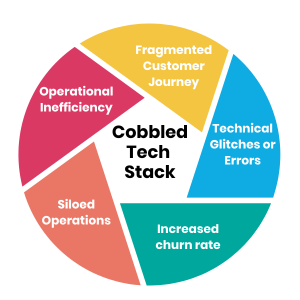


The Impact of Cobbled Tech Stack on Customer Experience




The tech stack you invest in not only affects your employee or operational efficiency but has a massive impact on your customer journey as well.
With the growth of the digital era in the last couple of years, we now have multiple digital channels to engage with our customers.
As amazing as it sounds, this can easily backfire.
With companies investing in a different tool for every channel or department, customer journeys become disjointed due to a lack of a consolidated view of the customer lifecycle.
But don’t worry, we come equipped with solutions! Get ready to inspect what causes a tech stack to become disjointed or cobbled, what is the impact of a cobbled tech stack on your customer journey, concluding with some tips to improve customer experience.
What is a Cobbled Tech Stack?
You know, when we talk about a cobbled tech stack, we're basically referring to a tech setup that's been put together bit by bit over time, kind of like a puzzle without a clear picture to guide it. Instead of having a well-thought-out plan from the start, it's more of a mix-and-match situation where different systems, apps, and software get added as the need arises. It's like building a bridge while you're crossing the river – it works, but maybe not as smoothly as it could if we had taken a more structured approach right from the beginning.
Factors Leading to a Cobbled Tech Stack
SaaS companies have done a notoriously fab job at marketing different tech services or tools as necessary, compelling businesses to invest in multiple tools - each serving a unique purpose. Consequently, this creates a breeding ground for a cobbled tech stack with a number of tools - each promising business growth without capabilities like integration or scalability.
Some other common factors leading to a cobbled tech stack are:
- Rapid Technological Advancement: The pace at which technology evolves often renders certain parts of a tech stack outdated. In an effort to stay current, businesses may add new technologies without fully considering how they fit into the existing infrastructure, leading to a disjointed assembly of tools and platforms.
- Organisational Changes: Events such as mergers and acquisitions can result in the amalgamation of different technology systems and practices without a concerted effort towards integration, causing a fragmented technology environment.
- Lack of a Coherent IT Strategy: Without a clear and overarching IT strategy, companies might make technology decisions based on short-term needs rather than long-term viability and coherence. This ad-hoc approach can result in a tech stack that seems cobbled together, lacking in efficiency and scalability.
- Inadequate Integration: Frequently, the integration between new and existing technologies is not thoroughly planned or executed, leading to operational inefficiencies and data silos that can hinder business processes and decision-making.
- Budget Constraints: Limited financial resources can force businesses to opt for less than ideal technology solutions that are affordable in the short term but may not be the best fit for the company's long-term needs, contributing further to the complexity and disjointedness of the tech stack.
If you find any of these factors relatable it might be time for a tech stack audit.
👉 Click here to learn how to conduct a tech stack audit.
Impact of a Cobbled Tech Stack on Your Customer Journey
The immediate consequences of a cobbled tech stack might seem primarily internal; however, the ripple effects on customer experience are substantial and adverse. These inefficiencies can impede a business's capacity to thrive in today's customer-centric market, emphasising the imperative need for a strategic approach to technology integration and adoption.

- Operational Inefficiency: A cobbled tech stack significantly undermines the overall customer experience by giving rise to various operational inefficiencies. The disjointed nature of these systems results in slower response times, impeding the seamless flow of data between platforms. This, in turn, leads to unnecessary delays for customers seeking swift and accurate support.
- Fragmented Customer Journey: The lack of integration within the tech stack contributes to a fragmented customer journey, making personalised interactions a challenging endeavour. This disjointed approach creates data silos, preventing businesses from obtaining a comprehensive view of the customer. Consequently, the ability to deliver tailored services or recommendations is hindered.
- Technical Glitches and Errors: Beyond operational challenges, system incompatibilities within a cobbled tech stack can lead to more frequent technical glitches or errors. Such disruptions impact the reliability of services provided. In today's landscape, where customers demand a seamless experience, technical issues can significantly erode trust and satisfaction.
- Customer Expectations: With advancements in technologies, customer patience has gradually decreased - well, if you tried to access a web page that took longer than 5 seconds you wouldn’t be a fan of the website either. Anyway, coming back to customer expectations - whether making a purchase, accessing services, or seeking support, they expect a smooth and uninterrupted experience. Businesses with an inefficient tech stack risk compromising customer trust and satisfaction, potentially leading to increased churn rates.
- Siloed operations: Data silos and misaligned departments within an organisation can wreak havoc on the customer journey. The lack of integration and reporting leads to a disjointed customer experience, hindering communication and diminishing customer satisfaction and loyalty. To execute effective go-to-market strategies, a holistic perspective on the tech stack is imperative.
For businesses, achieving a unified view of customer interactions and touchpoints is a pivotal objective. Fragmented customer journeys can lead to communication breakdowns, diminished satisfaction levels, and a decline in customer loyalty. As we navigate through the challenges arising from data silos and misaligned departments, it becomes evident that a cohesive approach is imperative for fostering positive customer experiences.
Tips to Optimise Tech Stack to Improve Customer Experience
We’ve discussed enough problems until now - data silos, redundant tools, disjointed customer journeys, operational inefficiencies, technical glitches, slow response times, and a lot more.
Let’s now explore how to optimise your entire go-to-market tech stack to improve customer experience:
- Conduct a Comprehensive Technology Audit: Begin by evaluating your current tech stack to identify redundancies, inefficiencies, or any outdated technologies that may be hindering performance. This audit should assess how each tool or system contributes to customer experience and identify gaps that need addressing.
- Define Clear Objectives: Clearly articulate what you aim to achieve by optimising your tech stack. Whether it's improving response times, ensuring system reliability, or offering personalised customer interactions, having specific, measurable goals will guide your technology decisions.
- Prioritise Integration: Seek out technologies that easily integrate with your existing systems. A tech stack where all components communicate seamlessly can significantly reduce data silos and operational inefficiencies, thus enhancing the overall customer experience.
- Invest in Scalable Solutions: Opt for technologies that not only meet your current needs but are also scalable. Scalable solutions can adapt to your business’s growth and evolving customer expectations, ensuring that your tech stack remains effective over time.
- Leverage Customer Data Insights: Utilise tools that offer robust data analytics capabilities. Insights gleaned from customer data can inform more personalised service delivery, tailor customer interactions, and anticipate customer needs, thereby elevating the customer experience.
- Implement Continuous Feedback Loops: Establish mechanisms to regularly collect and analyse customer feedback regarding your services and their interactions with your technology. This ongoing feedback is invaluable for making iterative improvements to both your tech stack and customer experience strategies.
- Partner with Experts: If necessary, consider partnering with RevOps consultants who can offer expertise in aligning your tech stack with your customer experience goals. Their knowledge can be instrumental in navigating the complex technology landscape and making informed decisions that benefit your customers and your business
By systematically addressing your tech stack with the aim of optimising customer experience, businesses can foster stronger relationships with their customers, improve loyalty, and drive sustainable growth.
These steps are not a one-time effort but part of an ongoing strategy to ensure that your technology continues to meet and exceed customer expectations.








